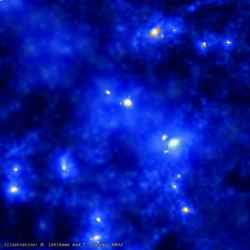
An accurate illustration of young galaxies twe<lve billion light years awayClick to enlarge/a>
Astronomers have found clear indications that clumps of dark matter are the nursing grounds for new born galaxies about twelve billion light years away. A single nest of dark matter can nurture several young galaxies. These results from researchers at the Space Telescope Science Institute, the National Astronomical Observatory of Japan, and the University of Tokyo confirm predictions of the currently dominant theory of cosmology known as the Cold Dark Matter model.
Recent studies suggest that dark matter out weighs ordinary matter by a factor of seven. Although dark matter cannot be seen directly through a telescope, it reveals itself to astronomers by its strong gravitational pull on nearby stars and gas, and even galaxies.
Galaxies are often clustered together and how they cluster is determined mostly by gravity.
By studying how galaxies cluster, it is possible to determine how dark matter is distributed and how it affects the birth and growth of galaxies. In the past, it was extremely difficult to study the clustering of young galaxies. Young galaxies appear faint due to their great distances, and finding enough of them to study how they cluster was an observational challenge.
Masami Ouchi from the Space Telescope Science Institute and colleagues used the Subaru telescope and its Suprime-Cam camera to study a piece of the sky in the constellation Cetus (the Whale) called the Subaru/XMM-Newton Deep Survey Field (SXDS). This piece of sky covers an area five times the size of the full moon. By taking deep and sensitive images of the field in three colors of visible light, the SXDS team was able to find about seventeen thousand (17,000) young galaxies twelve billion light years away. This number is ten times larger than previous studies of such young galaxies.
Based on these data, the team found that:
1) There are many pairs of galaxies with separations less than eight hundred thousand (800,000) light years.
2) Even at large distances, galaxies are strongly clustered.
Both of these results are expected if the galaxies are nestled within clumps of dark matter. The SXDS team compared the observational results in detail to theoretical predictions based on a Cold Dark Matter model by team member Takashi Hamana and found that the average clump of dark matter nests weighs as much as six hundred billion (600,000,000,000) Suns, and that a single clump of dark matter harbors multiple young galaxies.
Independently, Nobunari Kashikawa from the National Astronomical Observatory of Japan and colleagues also used Subaru’s Suprime-Cam camera to study an area of sky in the constellation Coma Berenices (Berenice’s Hair) called the Subaru Deep Field (SDF). This field is only the size of one full moon but the data available are twice as sensitive as the SXDS field data. The SDF team found about five thousand (5,000) young galaxies at a distance of twelve billion light years, and eight hundred (800) even younger galaxies at a distance of twelve billion five hundred million light years. The SDF team was also able to double check the identities of the young galaxies by taking spectral data of the galaxies with the Subaru and Keck telescopes. The SDF team independently obtained the results 1)+2) described above, and concluded that some single clumps of dark matter harbours multiple young galaxies. In the SDF images, it is possible to see several new born galaxies huddled together in a small area. By comparing the SDF data in detail to high precision computer simulations of the growth of clumps in Cold Dark Matter by team member Masahiro Nagashima of Kyoto University, the SDF team concludes that heavier clumps of dark matter have more bright galaxies, and that this preference produces the correlations found in real observation.
The two teams together have found the first concrete evidence that young galaxies in the early universe are nestled within clumps of dark matter, and that a single clump of dark matter nurses several young galaxies. Both teams took advantage of the Subaru telescope’s unique ability to take deep sensitive images over a large area of sky.
Original Source: NAOJ News Release
